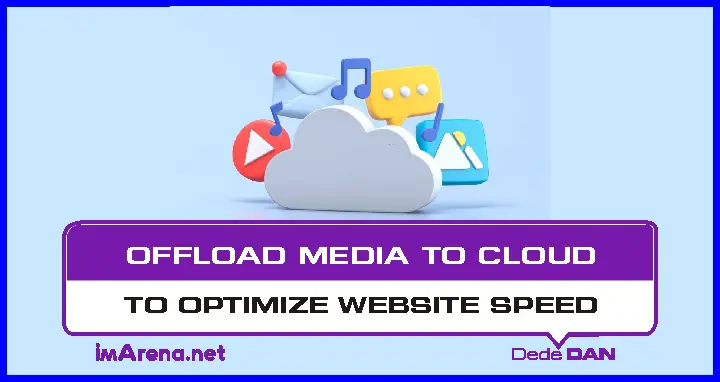

I hope you enjoy reading this blog post.
If you want my team to just do your marketing for you, click here.
Website speed plays a vital role in user experience and search engine optimization (SEO). Slow-loading websites can lead to increased bounce rates, decreased user engagement, and ultimately, negative impacts on business success.
To address this challenge, offloading media to cloud storage has emerged as a powerful solution.
This article explores the benefits and steps to optimize website speed by offloading media to cloud storage.
Understanding the Impact of Media on Website Speed
Before delving into the solution, it is crucial to understand how media files, such as images, videos, and audio, affect website loading time. These files, while essential for engaging content, can significantly slow down website performance if not managed effectively.
As websites grow, managing media files becomes increasingly challenging, leading to slow loading times and potential crashes.
Statistics and studies have consistently shown a direct correlation between website speed and user engagement, making it crucial to address media-related challenges.

My Agency can Help You Make Money Online
Cashcow Videos - we create engaging faceless cashcow and business explainer videos that earn passive income.
Monetized Blogs - select from our list of ready-made niche blogs that are already approved for monetization.
Business or Website Traffic - using various digital marketing strategies, we drive massive amounts of targeted traffic to your website.
Benefits of Offloading Media to Cloud Storage
Offloading media to cloud storage provides numerous benefits that can significantly improve website speed and performance.
1. Scalability and Handling Growing Demands
Traditional hosting options may struggle to keep up with the increasing demands of a growing website. Cloud storage solutions offer virtually limitless scalability, allowing you to store and serve as many media files as necessary without compromising performance.
With cloud storage, your media library can seamlessly scale alongside your website’s growth, ensuring a smooth user experience.
2. Improved Website Speed and Performance
By offloading media files to cloud storage, you can enhance website speed and performance. Cloud storage providers utilize Content Delivery Networks (CDNs), which cache and distribute your files across a global network of servers.
When a user visits your site, the media files are served from the server closest to them, reducing latency and ensuring faster load times. Google Cloud Storage, Amazon S3, and DigitalOcean Spaces are leading providers that excel in delivering fast content to users worldwide.
3. Ensuring Accessibility and Reliability
Maintaining a reliable website is crucial for user satisfaction. Cloud storage services offer distributed data centers, automatically storing multiple copies of your media files. This redundancy ensures that your files remain accessible even if one data center experiences an outage. With cloud storage, you can minimize downtime and provide a seamless browsing experience to your users.
4. Cost-effectiveness and Efficient Storage Management
Storing and serving media files can be costly, especially with traditional hosting solutions. Cloud storage services offer cost-effective pricing models, allowing you to pay only for the storage and bandwidth you use.
As your website grows, you can easily adjust your expenses based on your requirements, making cloud storage an economical choice for managing media files. Additionally, cloud storage providers handle the management and maintenance of the storage infrastructure, freeing up your resources and time for other important tasks.
5. Enhanced Security and Data Protection
Protecting your website’s media files from unauthorized access and data breaches is essential. Cloud storage services employ advanced encryption methods to safeguard your files both in transit and at rest. Regular security audits ensure that your data remains secure.
Providers like Amazon S3 and Google Cloud Storage offer additional security features, such as access control policies and server-side encryption, allowing you to fine-tune access permissions and protect your valuable assets.
Top Cloud Storage Providers for Offloading Media Files
When considering offloading media files to cloud storage, several top providers stand out for their features, performance, and reliability. These providers include:
Google Cloud Storage
Google Cloud Storage is a powerful player in the cloud storage market, offering robust features and seamless integration with Google’s extensive ecosystem. It provides various storage services, including Filestore, Persistent Disks, and Cloud Storage, to accommodate diverse requirements.
Google Cloud Storage’s key features include competitive pricing, a high-performance global network with built-in CDN, automatic data encryption, and integration with other Google services like Google Analytics and BigQuery. Famous brands like Target and Goldman Sachs trust Google Cloud Storage for their media file management needs.
Amazon S3
Amazon S3 (Simple Storage Service) is a popular and reliable cloud storage solution within the Amazon Web Services (AWS) ecosystem. It offers unlimited storage capacity, flexible storage classes for cost optimization, and seamless integration with Amazon CloudFront CDN for faster media delivery.
With pay-as-you-go pricing and advanced security measures like server-side encryption and access control policies, Amazon S3 is trusted by renowned brands like Siemens and Sysco for their media file offloading requirements.
DigitalOcean Spaces
DigitalOcean Spaces stands out as a user-friendly and developer-focused object storage solution. It offers high-functioning servers, excellent service, and great customer support. DigitalOcean Spaces provides straightforward pricing, a built-in CDN for improved content delivery, and easy integration with your WordPress site.
It’s a cost-effective choice for managing multiple media files. Brands like Loot.tv and Pionect rely on DigitalOcean Spaces for their media storage needs.
Preparing Media Files for Cloud Storage
Before offloading media files to cloud storage, it is essential to optimize them for the web. Optimization includes compression, resizing, and selecting appropriate file formats. These steps reduce file sizes without compromising quality, resulting in faster loading times.
Additionally, organizing media files efficiently and considering image and video quality maintenance are crucial aspects of preparing media files for cloud storage.
Implementing Lazy Loading and Content Delivery Networks (CDNs)
Lazy loading is a technique that helps improve website speed by loading media files only when they are visible to the user. By implementing lazy loading, you can reduce the initial load time and improve overall performance. Integration of lazy loading with cloud storage and website ensures that media files are loaded on-demand, leading to faster page rendering.
Content Delivery Networks (CDNs) further enhance speed and performance by caching and serving media files from servers geographically closer to the user, reducing latency.
Testing and Analyzing Website Performance
To optimize website speed, it is crucial to measure and analyze performance using tools like PageSpeed Insights and GTmetrix. These tools provide insights into various performance metrics, such as page load time, server response time, and resource optimization opportunities.
Interpreting these metrics, you can identify areas for improvement and optimize website elements for optimal speed.
Best Practices for Maintenance and Monitoring
Once media files are offloaded to cloud storage, ongoing maintenance, and monitoring are essential to ensure consistent speed optimization. Regular monitoring of website speed and media file performance helps identify potential issues and fine-tune configurations.
Handling updates and changes to media files in cloud storage requires proper versioning and maintenance procedures. Adhering to best practices and implementing routine maintenance tasks ensure that your website continues to deliver an optimal user experience.
Case Studies and Success Stories
Real-world examples provide valuable insights into the benefits of offloading media to cloud storage. Case studies highlight websites that have successfully implemented this optimization technique, showcasing performance improvements achieved and lessons learned.
Analyzing these success stories can provide inspiration and practical guidance for implementing media offloading strategies effectively.
Conclusion
Optimizing website speed is crucial for providing an exceptional user experience and improving business outcomes. Offloading media files to cloud storage offers numerous benefits, including scalability, improved speed and performance, reliability, cost-effectiveness, and enhanced security. Following best practices can significantly optimize website speed and provide a seamless browsing experience for your users.





